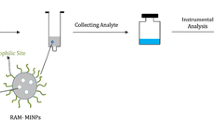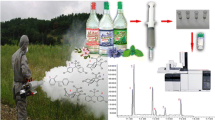Abstract
A deep eutectic solvent functionalized graphene oxide composite adsorbent (DFG) was synthesized through reversible-addition fragmentation chain-transfer polymerization. The synthesized DFG had multiple adsorption interactions after covalent modification with a deep eutectic solvent (allyltriethylammonium bromide/ethylene glycol). Adsorption isotherms and kinetics studies of DFG indicate that the adsorption of hippuric acid (HA) and methylhippuric acid (MHA) was monolayer chemical adsorption. The comparison of DFG with commercial adsorbents demonstrates that the adsorption ability of DFG was superior. This was due to the multiple adsorption interactions of DFG for the three analytes (mainly π-interaction, hydrogen bonding, electrostatic adsorption, and hydrophobic interaction). The DFG adsorbent was applied to miniaturized pipette-tip solid-phase extraction (MPT-SPE), followed by high-performance liquid chromatography (HPLC) to determine biomarkers in urine for toluene and xylene exposure. The DFG-MPT-SPE-HPLC method required only 2.00 mg of DFG as adsorbent, 0.50 mL of washing solvent, and 0.40 mL of elution solvent to achieve a wide linear range (0.200–200 μg mL−1), high recoveries (90.9–99.1%), and high precision (RSD ≤ 6.3%). The proposed method was applied to determine HA and MHA in urine samples from occupational workers.

Deep eutectic solvent functionalized graphene oxide composite adsorbent for miniaturized pipette-tip solid-phase extraction of toluene and xylene exposure biomarkers in urine prior to their determination with HPLC-UV.


Similar content being viewed by others
References
Omidi F, Behbahani M, Khadem M, Golbabaei F, Shahtaheri SJ (2018) Application of ultrasonication for facilitating the extraction of hippuric acid and methyl hippuric acid in real samples using Fe3O4@SiO2@sodium dodecyl sulfate: experimental design methodology. Anal Methods 10(37):4588–4595
Pirmohammadi Z, Bahrami A, Nematollahi D, Alizadeh S, Shahna FG, Rahimpoor R (2020) Determination of urinary methylhippuric acids using MIL-53-NH2 (Al) metal-organic framework in microextraction by packed sorbent followed by HPLC-UV analysis. Biomed Chromatogr 34(1):e4725
Yamazaki K, Tanaka E, Misawa S (1992) Urinary ortho-crsol concentrations as an indicator of toluene in halation in glue-sniffers. J Forensic Sci Soc 32:215–223
U.S. Department of Health and Human Services, Public Health Service, Agency for Toxic Substances and Disease Registry (2007) Toxicological Profile for Xylene. 123–125
Saito T, Takeichi S (2002) Simultaneous detection of hippuric acid and methylhippuric acid in urine by empore™ disk and gas chromatography-mass spectrometry. J Pharm Biomed Anal 30(2):365–370
Omidi F, Behbahani M, Khadem M, Golbabaei F, Shahtaheri SJ (2019) Application of a new sample preparation method based on surfactant-assisted dispersive micro solid phase extraction coupled with ultrasonic power for easy and fast simultaneous preconcentration of toluene and xylene biomarkers from human urine samples. J Iran Chem Soc 16(6):1131–1138
Kongtip P, Vararussami J, Pruktharathikul V (2001) Modified method for determination of hippuric acid and methylhippuric acid in urine by gas chromatography. J Chromatogr B Biomed Sci Appl 751(1):199–203
Moein MM, El-Beqqali A, Javanbakht M, Karimi M, Akbari-Adergani B, Abdel-Rehim M (2014) On-line detection of hippuric acid by microextraction with a molecularly-imprinted polysulfone membrane sorbent and liquid chromatography-tandem mass spectrometry. J Chromatogr A 1372:55–62
Zuppi C, Rossetti DV, Vitali A, Vincenzoni F, Giardina B, Castagnola M, Messana I (2003) Determination of urinary hippuric acid by micellar electrokinetic capillary chromatography. J Chromatogr B 793:223–228
Ghamari F, Bahrami A, Yamini Y, Shahna FG, Moghimbeigi A (2017) Hollow-fiber liquid-phase microextraction based on carrier-mediated transport for determination of urinary methyl hippuric acids. Toxicol Environ Chem 99(5–6):760–771
Maciel EVS, de Toffoli AL, Neto ES, Nazario CED, Lanças FM (2019) New materials in sample preparation: recent advances and future trends. Trends Anal Chem 119:115633
Gonzalez JL, Pell A, Lopezmesas M, Valiente M (2018) Hollow fibre supported liquid membrane extraction for BTEX metabolites analysis in human teeth as biomarkers. Sci Total Environ 630:323–330
Behbahani M, Bagheri S, Omidi F, Amini MM (2018) An amino-functionalized mesoporous silica (KIT-6) as a sorbent for dispersive and ultrasonication-assisted micro solid phase extraction of hippuric acid and methylhippuric acid, two biomarkers for toluene and xylene exposure. Microchim Acta 185(11):505
Hu C, Yang Z, Yan F, Sun B (2019) Extraction of the toluene exposure biomarkers hippuric acid and methylhippuric acid using a magnetic molecularly imprinted polymer, and their quantitation by LC-MS/MS. Microchim Acta 186(3):135
Arabi M, Ghaedi M, Ostovan A (2017) Water compatible molecularly imprinted nanoparticles as a restricted access material for extraction of hippuric acid, a biological indicator of toluene exposure, from human urine. Microchim Acta 184(3):879–887
Zang X, Chang Q, Liang W, Wu T, Wang C, Wang Z (2018) Micro-solid phase extraction of chlorophenols using reduced graphene oxide functionalized with magnetic nanoparticles and graphitic carbon nitride as the adsorbent. Microchim Acta 185(1):18
Guo X, Du B, Wei Q, Yang J, Hu L, Yan L, Xu W (2014) Synthesis of amino functionalized magnetic graphenes composite material and its application to remove Cr (VI), Pb (II), Hg (II), Cd (II) and Ni (II) from contaminated water. J Hazard Mater 278:211–220
Nouri N, Khorram P, Sereshti H (2019) Applications of three-dimensional graphenes for preconcentration, extraction, and sorption of chemical species: a review. Microchim Acta 186(4):232
Zhang H, Wu X, Yuan Y, Han D, Qiao F, Yan H (2018) An ionic liquid functionalized graphene adsorbent with multiple adsorption mechanisms for pipette-tip solid-phase extraction of auxins in soybean sprouts. Food Chem 265:290–297
Zhang Y, Zhou H, Zhang ZH, Wu XL, Chen WG, Zhu Y, Fang CF, Zhao YG (2017) Three-dimensional ionic liquid functionalized magnetic graphene oxide nanocomposite for the magnetic dispersive solid phase extraction of 16 polycyclic aromatic hydrocarbons in vegetable oils. J Chromatogr A 1489:29–38
Wang J, Zhou Y, Wang M, Bi W, Li H, Chen DDY (2018) High-throughput analysis for artemisinins with deep eutectic solvents mechanochemical extraction and direct analysis in real time mass spectrometry. Anal Chem 90(5):3109–3117
Li G, Row KH (2019) Utilization of deep eutectic solvents in dispersive liquid-liquid micro-extraction. Trends Anal Chem 120:115651
Shishov A, Bulatov A, Locatelli M, Carradori S, Andruch V (2017) Application of deep eutectic solvents in analytical chemistry. A review. Microchem J 135:33–38
Pethsangave DA, Khose RV, Wadekar PH, Some S (2017) Deep eutectic solvent functionalized graphene composite as an extremely high potency flame retardant. ACS Appl Mater Interfaces 9(40):35319–35324
Wang X, Li G, Row KH (2017) Graphene and graphene oxide modified by deep eutectic solvents and ionic liquids supported on silica as adsorbents for solid-phase extraction. Bull Kor Chem Soc 38:251–257
Hayyan M, Abo-Hamad A, Al-Saadi MAA, Hashim MA (2015) Functionalization of graphene using deep eutectic solvents. Nanoscale Res Lett 10:324
Zhuravlev OE, Nikolskii VM, Voronchikhina LI (2013) Thermal stability of quaternary ammonium hexafluorophosphates and halides. Russ J Appl Chem 86:824–830
Xu K, Wang Y, Wei X, Chen J, Xu P, Zhou Y (2018) Preparation of magnetic molecularly imprinted polymers based on a deep eutectic solvent as the functional monomer for specific recognition of lysozyme. Microchim Acta 185:146
Yuan Y, Nie H, Yin J, Han Y, Lv Y, Yan H (2020) Selective extraction and detection of β-agonists in swine urine for monitoring illegal use in livestock breeding. Food Chem 313:126155
Han S, Su L, Zhai M, Ma L, Liu S, Teng Y (2019) A molecularly imprinted composite based on graphene oxide for targeted drug delivery to tumor cells. J Mater Sci 54(4):3331–3341
Jian NG, Liang SH, Cao JK, Di QN, Kang K, Xu Q (2019) A nanofiber mat prepared from sulfonated polyaniline for solid-phase extraction of fluoroquinolones from water and biological fluids prior to their quantitation by UPLC-MS/MS. Microchim Acta 186(12):857
Wang M, Gao M, Zhang K, Wang L, Wang W, Fu Q, Xia Z, Gao D (2019) Magnetic covalent organic frameworks with core-shell structure as sorbents for solid phase extraction of fluoroquinolones, and their quantitation by HPLC. Microchim Acta 186(12):827
Shrivastava A, Gupta VB (2011) Methods for the determination of limit of detection and limit of quantitation of the analytical methods. Chron Young Sci 2(1):21–25
Ahmadi F, Asgharloo H, Sadeghi S, Gharehbagh-Aghababa V, Adibi H (2009) Post-derivatization procedure for determination of hippuric acid after extraction by an automated micro solid phase extraction system and monitoring by gas chromatography. J Chromatogr B 877(27):2945–2951
Acknowledgments
This work is supported by the National Natural Science Foundation of China (81803287), the Natural Science Foundation of Hebei Province (B2018201270, H2019201288), the Talent Engineering Training Foundation of Hebei Province (A201802002), and the Outstanding Doctoral Cultivation Project of Hebei University (YB201703).
Author information
Authors and Affiliations
Corresponding author
Ethics declarations
Conflict of interest
The authors declare that they have no competing interests.
Additional information
Publisher’s note
Springer Nature remains neutral with regard to jurisdictional claims in published maps and institutional affiliations.
Electronic supplementary material
ESM 1
(DOCX 1716 kb)
Rights and permissions
About this article
Cite this article
Yuan, Y., Han, Y., Yang, C. et al. Deep eutectic solvent functionalized graphene oxide composite adsorbent for miniaturized pipette-tip solid-phase extraction of toluene and xylene exposure biomarkers in urine prior to their determination with HPLC-UV. Microchim Acta 187, 387 (2020). https://doi.org/10.1007/s00604-020-04370-z
Received:
Accepted:
Published:
DOI: https://doi.org/10.1007/s00604-020-04370-z




